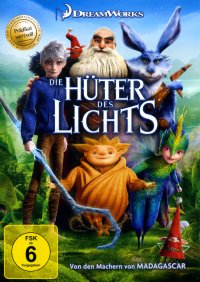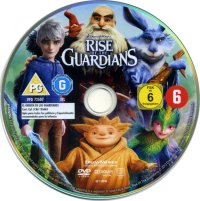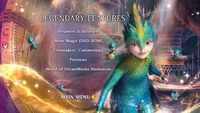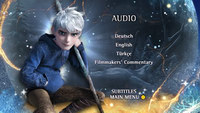
5.11.2013 #571
by Guido Bibra
• Dreamers & Believers Featurette
![]() The Movie
The Movie
Jack Frost does not know anything about himself except that he is the one bringing ice and snow to the world. For three centuries he is almost alone, only fleetingly aware of other creatures like him - but then he is summoned to the north pole, where he meets his colleagues North, Tooth and Sandy for the first time. But the get-together has a serious reason - Pitch, the evil bogeyman, wants to destroy the four Guardians watching over the dreams and safety of the world's children...
He mainly writes children's books, but he is no stranger to all sorts of media - William Joyce has been writing since the beginning of the 1980s and first became involved in animated filmmaking in the 1990s. He worked as a conceptual designer on Toy Story and A Bug's Life for Pixar, co-created BlueSky's Robots, adapted and produced Meet the Robinsons for Disney from his own story and created the television series Rolie Polie Olie and George Shrinks based on his own books. It seemed William Joyce was everywhere, but one of his endeavours took some detours before it finally came to fruition.
Long before the first book in his new series of novels called The Guardians of Childhood was published in 2011, William Joyce had founded his own CGI animation production company Aimesworth Amusements together with the Californian company Reel FX. Their first and only project was the short film called The Man in the Moon, which was the first inkling of a new idea that mythical figures like Father Christmas, the Easter Bunny or the Sandman are watching over the well-being of the world's children and are dependent on their belief in them. The Guardians of Childhood were born, but the film was either never finished or remained deliberately unreleased. Aimesworth Amusements was never heard of again, but after William Joyce had two big successes with Robots and Meet the Robinsons, he was able to resurrect the Guardians.
In 2008, Dreamworks Animation expressed interest in William Joyce's idea and he was able to sell the film rights to them under the strict condition that he would be closely involved in a proposed film production and also get veto rights - which the studio was only happy to grant. It was only the third time that Dreamworks had worked with an author instead of producing original content - after William Steig's Shrek in 2001, the collaboration with Cressida Cowell on How To Train Your Dragon was already well underway at that point, but William Joyce had not actually written any books yet. To get the idea of the Guardians off the ground, the author made a unique proposal: instead of writing a book to adapt it into a movie, he would introduce each Guardian in a separate novel with an extensive back story, while a movie would contain a standalone story happening after the events of the books, bringing all Guardians together for the first time.
The movie went into development in 2009 with William Joyce as co-director and Peter Ramsey at the helm, who had joined Dreamworks as a storyboard artist in the mid 2000s and had recently directed the half-hour halloween television special Mutant Pumpkins from Outer Space, a follow-up to Monsters vs. Aliens. In the Dreamworks tradition of promoting long-time animation artists to directors, Ramsey was one of the many people who had reached the director's chair this way, but, as a lot of journalists remarked, he is actually the first african-american to direct a big-budget cgi animated production. For the script, William Joyce chose his longtime collaborator David Lindsay-Abaire, a renowned playwright with a Pulitzer Drama Prize and several Tony Awards under his belt.
While William Joyce prepared the release of his first Guardians of Childhood novel, he also acted as co-director, co-writer and sometimes designer on the movie, which was slowly taking shape parallel to the books. In 2011, however, the production was overshadowed by the tragic death of Joyce's 18-year old daughter Katherine, who had suffered from a brain tumor. Later William Joyce revealed that the idea of the Guardians was based on a question of his then-young daughter, who asked if the Tooth Fairy and the Easter Bunny knew each other. With the devastating loss of his daughter, the author had understandably stepped down as co-director and while Dreamworks had offered to stop the movie's production out of respect for the family, Joyce chose to remain as executive producer to continue the already very advanced development of Rise of the Guardians as a tribute to his daughter,
The idea of the Guardians was not entirely new. Terry Pratchett had already extensively explored the concept of gods and other mythical beings dependent on the belief of humans in his Discworld universe. His 1995 novel Hogfather, which had been successfully adapted into a live-action television two-parter in 2005, has an astonishingly similar plot to the Rise of the Guardians movie, except that it is more a fantasy satire than the children's story William Joyce had envisioned. His approach is considerably simpler and more straightforward than Terry Pratchett's ideas, but the parallels are nevertheless quite remarkable. Joyce does without creating a completely new universe, instead his stories happen in a slightly modified fairytale reality, giving the mythical beings many children believe in new personalities which surprisingly even sometimes border on satire themselves.
Even though the story does not have the luxury of getting every character properly established - a job for the simultaneously published books - the protagonists are strong. Jack Frost, whose story the movie actually revolves around, is a concept brilliant in its simplicity - a frustrated young teenager who has gone unnoticed in the world despite his best efforts to bring winter to the world. North alias Father Christmas is a deft interpretation of the usual cliche-ridden jolly round man - instead he is built like a wrestler, his north pole lair is a toy manufacturing company and his elves are little pointy mischiveous troublemakers.
Tooth, a bubbly cross between a young girl and a hummingbird, runs a similarly grand operation collecting children's teeth, as does Bunny, a handsome hunk of a rabbit, with the delivery of easter eggs around the world. And there's also Sandy, a funny little fellow who speaks in symbols appearing over his head, who is responsible for bringing the children happy dreams. The only disappointment of the bunch is actually the antagonist: Pitch, the evil bogeyman, despite his powers just appears as a one-dimensional creepy bully who very obviously seems to be modeled on a certain similar character from another certain franchise.
While the characters are mostly fine, the plot is not - the movie suffers from a dissapointingly simple story, which is somewhat unusual for Dreamworks Animation. What the movie actually wants to be about is the story of Jack Frost, searching for his true identity, but this is almost obliterated by a very thin good-against-evil fight with the very simple antagonist Pitch, the literal bogeyman, wanting to obliterate his colleagues by destroying the children's belief in them with fear. This, however, seems to be just an excuse to construct the plot around a couple of major 3D action scenes, which have only been superficially integrated in the barely existing plot. This is where Rise of the Guardians has a striking similarity to the equally weak Kung Fu Panda 2, which suffers from basically the same predicament, Not even the strongly developed characters and their often quite funny and poignant dialogue can really overcome the lack of proper storytelling, which makes Rise of the Guardians barely recognizable as a Dreamworks Animation movie.
Another surprise is the extremely dark mood of Rise of the Guardians. Obviously taking a cue from the Harry Potter movies, the story is not cheerful at all, but very dramatic to the point of being pessimistic and scary. There seems to be a lot of effort to lighten the story with some humour from the often very funny characters, but this is unfortunately mostly lost in the drama. Rise of the Guardians also suffers from a sort of identity crisis - the movie wants to be compatible for children, yet there is an astonishing amount of violence. The fight scenes are not the usual cartoony acrobatics, but leave a very brutal and frightening impression - one of the main characters is even killed by the antagonist, albeit only temporary. The uneven tone of the movie is a surprise, especially because filmmakers Guillermo del Toro had again been hired as a consultant and became an executive producer, which had positive influences in the past.
Despite the weak story and the moody atmosphere, Rise of the Guardians earns major points with amazingly detailed and intricate visuals, which nearly, but not completely save the movie. The film is an utter marvel to look at, even in the flat 2D version the imaginary fairytale world comes magnificently to life. William Joyce, an illustrator and designer in his own right, seems to have worked closely with production designer Patrick Marc Hanenberger and art director Max Boas, both longtime Dreamworks artists, on the amazing look of the movie which far surpasses the weak script. The involvement of cinematographer Roger Deakins, who had already worked with Dreamworks on How to train your Dragon, also contributed a lot to the amazing look of the movie. Visually, Rise of the Guardians is far away from being just a case of "been there, done that", but proves to be really creative and imaginative, albeit sometimes a bit overwhelming.
The character design is similarly fascinating, but only when it comes to the fairytale creatures. With the human characters, Dreamworks (and for that matter, most other animation studios) seems to have hit a wall finding the right approach to make them either too real or too cartoony. In the last movies with predominantly human characters, Dreamworks' animation department had found exactly the right balance, but since then there has been not much variety in the designs, making most of the faces look digital and lifeless again. Even Jack Frost himself has very advanced facial expressions, but it looks like the designers could not decide whether making him entirely realistic or not. This is especially noticeable in contrast to all fantasy and animal characters, who seem to have gotten all the attention of the animators and designers - even North alias Father Christmas is more alive and breathing than Jack Frost and especially the children appearing in the last half of the movie.
The choice of the voice cast is, however, absolutely spot on and, as always with Dreamworks, not only a case of assembling just a bunch of random movie stars. The lead role of Jack Frost went to Chris Pine, who became the next incarnation of Captain James T. Kirk in the new Star Trek franchise in 2009 and had since been one of the most sought-after next-generation actors in Hollywood, appearing in tragedies, comedies and action movies alike. In Rise of the Guardians, his first and to date only animation voiceover, he actually appears surprisingly incognito by playing Jack Frost as a somewhat cocky and unruly teenager - with the slight problem that the 32-year old Pine sometimes sounds a little too old for the character.
The biggest surprise of the voice actors is Alec Baldwin, who almost unrecognizably plays North, the unusual interpretation of Santa Claus with a surprisingly thorough and only slightly exaggerated Russian accent, making him the most fun to listen to. Baldwin seems to have had genuine fun with his character and only sounds like his old self in a couple of instances, which is pretty amazing considering his very distinct voice. The actor is, of course, an old Dreamworks acquantance - he voiced the antagonist in Madagascar 2 and is always on the rumour list when a new movie of the studio is announced. Hugh Jackman as the Easter Bunny, who actually appears as an athletic human sized rabbit, also makes his second appearance after the lead role in the Dreamworks-Aardman collaboration Flushed Away, but this time he deftly dons his native Australian accent and not only has as much fun as his colleague Alec Baldwin, but also pokes a little fun at himself.
Isla Fisher is also no stranger to animated movies, since the scottish-australian actress was already part of BlueSky's Dr. Seuss adaptation Horton Hears A Who and Gore Verbinski's western tribute Rango, but here she sounds basically like herself. She plays Tooth, the strange hummingbird girl as a bit of a motormouth who is overly enthusiastic about everything, but can also be very emotional and emphatic. Not the same can be said about the casting of the antagonist Pitch, who is voiced by Jude Law in a very theatrical, yet oddly detached and unexciting performance. There is no doubt about the abilities of the actor, but considering that Rise of the Guardians is actually his first appearance in an animated movie, he really seems to have phoned his character in.
A big and positive surprise is the music of Rise of the Guardians. For the first time, a Dreamworks Animation production was not scored by one of Hans Zimmer's stable - instead the filmmakers chose to work with the french composer Alexandre Desplat, whose much more traditional and symphonic style was a welcome change from the now all to similar sounding scores of the studio's previous movies. Desplat had only been composing for big-budget Hollywood productions since the mid-2000s and since then has been extremely busy on both sides of the ocean. Rise of the Guardians had been only one of nine movies coming out in 2012 he had written and often himself conducted music for, but despite his heavy workload his first score for Dreamworks sounds completely fresh and original.
Staying away from every bit of electronic rhythms or even jazzy drums, the composer relies entirely on old-fashioned orchestral sounds, but the real surprise of his score are the wonderful melodies which dominate the whole sound of the movie.
While his Dreamworks colleagues today often work more with chords and harmonies, he delights with a multitude of sometimes simple and sometimes very intricate themes and uses them in many variations. It may not rival the classical composers, but Desplat's score for Rise of the Guardians is almost a symphony for itself and a return to the classic film composing of the 1940s and 1950s. Staying true to the tone, the movie closes not with a loud pop song, but with an almost operatic piece called Still Dream beautifully interpreted by opera singer Renée Fleming. The only occurences of source music in the whole movie are a fleeting bit of a folk tune called Kemp's Jig and an excerpt of Igor Stravinsky's Firebird Suite North listens to in his workshop - otherwise the movie is refreshingly devoid of any contemporary pop songs.
Rise of the Guardians could have been a fabulous and perfect Dreamworks movie, but somewhere during the production the filmmakers seem to have lost their way and abandoned the core principle of good storytelling. After a promising beginning, the movie quickly degenerates into an unusually violent spectacle, which admittedly looks absolutely stunning. But the amazing visuals and the fascinating characters with their entertaining voices are unfortunately not able to counterbalance the weak and formulaic script. This is unfortunately a Dreamworks movie without many of the Dreamworks trademarks - the lack of a feel-good atmosphere makes Rise of the Guardians not as fun to watch as many of its predecessors and especially not suitable for younger children.
Considering that Rise of the Guardians and its tie-in books, which had already begun publication in 2011 well in advance, were marketed predominantly for schoolchildren, the very dark tone of the movie and the novels is their biggest problem. When it premiered all over the world in November 2012, the boxoffice results were lukewarm at best and the reaction from the critics was also not overly positive, with many citing the lack of a good story and the focus on the 3D action sequences. The movie clearly failed to gel with the American audience and the rest of the world seemed to agree. Costing 145 million dollar, Rise of the Guardians barely managed to take twice its budget back on the worldwide boxoffice, the worst financial result of a Dreamworks Animation movie for a long time.
Because this was only the third collaboration with an outside author and How to train your Dragon previously had become a spectacular success despite a difficult production history, it is hard to imagine that Dreamworks Animation had not seen the problems of Rise of the Guardians coming. It may have been a case of trusting too much in the writing team of William Joyce and David Lindsay-Abaire, whose work seem to be completely disconnected to the usual style of Dreamworks Animation, catering for the younger and older viewers alike. Here, the connection seems broken, with the dark and violent tone not matching the much too simple fairytale-like story at all. Rise of the Guardians had a lot of potential to be a friendly, exciting adventure like Kung Fu Panda, but it seems the author had different plans.
Rise of the Guardians is certainly not a catastrophically bad movie, but the series of missteps made it into a big problem for the studio. Tt was the first time one of their productions had not turned a profit and the loss of over 80 million dollars in the fourth quarter of 2012 was serious enough that the company was heavily restructured in Spring 2012 with over 350 people laid off. The home video sales were, however, much more successful with over five million DVDs and Blu-Rays sold worldwide. This prompted Director Peter Ramsey and creator William Joyce to lobby for a continuation of the planned movie franchise, but over a year after the movie's premiere, Dreamworks has not yet made a decision. Meanwhile the Spring 2013 release of The Croods had brought the studio a much needed financial success, further mitigating the loss from Rise of the Guardians. It was also the last movie under the six-year-distribution contract with Paramount, beginning in 2013 the worldwide Dreamworks distribution was switched to 20th Century Fox.
![]() The DVD
The DVD
Rise of the Guardians was quickly released on DVD and Blu-Ray all over the world in Spring 2013 only about four months after the cinema premiere, but not in as many different flavours as some previous Dreamworks movies. Apart from separate 2D and 3D Blu-Rays the movie was also released on DVD, which contained most of the extras from the high-definition releases. The more expensive 3D release was also bundled with the 2D Blu-Ray and a DVD, but this disc is as usual not identical with the standalone release and has a digital copy instead of the DVD extras.
The disc reviewed in this article is the seperate German DVD released in April 2013, which actually seems to be identical in some parts of Europe, since it also has ratings for several other countries including England and Ireland on the disc. The initial release price ranging from 15 to almost 18 Euro instead of the usual 12 to 14 Euro of the previous Dreamworks movies prompted me to hold off with a purchase until the autumn. While I was not overly impressed with the movie, the DVD is certainly very good from a technical perspective, making it a nice final joint release from Paramount and Dreamworks.


![]() Image
Image
The european PAL DVD of Rise of the Guardians of course only contains the 2D version of the movie, but the quality is so perfect that it borders on a high definition presentation. After several movies in the wide scope aspect ratio of 2.40:1, Rise of the Guardians was again produced in 1.85:1, which was opened as usual to 1.78:1 for the home video presentation.
The direct conversion from the high definition master into the DVD format is once again absolutely flawless and makes use of every last pixel. There does not seem to filtering of any kind, the image just looks like a very clean resize from the higher resolution. Sharpness is perfect without being heavily noticeable - there is an amazing amount of detail in the image, but not thanks to additional electronic sharpening. The wide colour palette of the movie is perfectly replicated from the almost monochrome opening scenes to the many playfully saturated sequences which seem to really pop through the screen even in the flat version.
The authoring is also absolutely no problem, the bitrate constantly hovers around 8.5 mbit/s which still leaves enough room for the image even with the four soundtracks. No compression artifacts are visible even in the faster moving sequences - this is a movie the compressors would have had a lot of problems ten years ago.
![]() Sound
Sound
The European DVD release of Rise of the Guardians sports the usual tri-language soundtrack collection in Dolby 5.1. Unfortunately, there has been no PAL speedup correction again, so that the soundtrack on the European DVD editions runs and sounds about 4% faster and higer than in cinemas and on the Blu-Ray.
The English 5.1 soundtrack has a very active, but sometimes a bit agressive mix making good use of all six channels - for the Blu-Ray, Rise of the Guardians was actually mixed into 7.1 with enhanced surround, but the DVD just gets the usual 5.1 mix in 448 kbit/s. Alexandre Desplat's intricate score is clearly the star of the soundtrack, filling the frontal and rear soundstages together with the very detailed and realistic sound effects. In some scenes, however, the soundmix gets a little to enthusiastic and becomes a loud and booming mess, even drowning out the dialogue sometimes. The voices are not locked on the center channel, but often freely roam around the frontal three channels.
The German and Turkish 5.1 tracks sound almost identical to the English version save for the other voices, but even these have faithfully been mixed the same way as in the original. Subtitles are provided in all three languages on the feature movie and the extras.
![]() Extras
Extras
The extras of the DVD editions thankfully contains at least some of the material of the Blu-Ray, most importantly the audio commentary, but only one of the several featurettes has actually made it onto the disc.
The Commentary with director Peter Ramsey and producers Christina Steinberg and Nancy Bernstein reveals much about the production of the movie, with the filmmakers recounting the development process in great detail. Not surprisingly, the visuals are the main thing being talked about and the actual storytelling is only superficially mentioned - it is not as if the filmmakers exhibit some spectacularly wrong work, but even here the underlying problems of the weak script are noticeable. Nevertheless the commentary is very interesting to listen to - the director and his two producers are very friendly, amiable and always recognize the enormeous talent of their co-workers.
Dreamers & Believers (10:20) is a short Making Of fluff piece about the characters of the movie and their actors. As usual, about the only interesting aspect of this is that you get to see the talent behind the voices working in the sound studio, but otherwise there is not much substance despite the director and producers also making appearances.
More Magic is just a pointer to what the DVD-ROM part contains - there are six PDF files with beautifully made printables, which are surprisingly geared towards younger children to which the movie is decidedly unsuitable.
Previews has trailers for The Croods, the two Dreamworks television series Dragons - Riders of Berk and Kung Fu Panda - Legends of Awesomeness and the Rise of the Guardians video game.
World of Dreamworks Animation has more short musical trailers for four of the major franchises from the studio.



